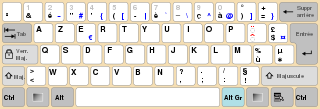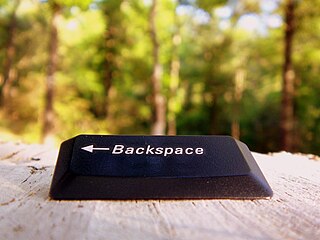
A diacritic is a glyph added to a letter or to a basic glyph. The term derives from the Ancient Greek διακριτικός, from διακρίνω. The word diacritic is a noun, though it is sometimes used in an attributive sense, whereas diacritical is only an adjective. Some diacritics, such as the acute ⟨á⟩, grave ⟨à⟩, and circumflex ⟨â⟩, are often called accents. Diacritics may appear above or below a letter or in some other position such as within the letter or between two letters.

QWERTY is a keyboard layout for Latin-script alphabets. The name comes from the order of the first six keys on the top letter row of the keyboard. The QWERTY design is based on a layout included in the Sholes and Glidden typewriter sold via E. Remington and Sons from 1874. QWERTY became popular with the success of the Remington No. 2 of 1878, and remains in ubiquitous use.
The circumflex is a diacritic in the Latin and Greek scripts that is also used in the written forms of many languages and in various romanization and transcription schemes. It received its English name from Latin: circumflexus "bent around"—a translation of the Greek: περισπωμένη.
The tilde˜ or ~, is a grapheme with a number of uses. The name of the character came into English from Spanish, which in turn came from the Latin titulus, meaning 'title' or 'superscription'. Its primary use is as a diacritic (accent) in combination with a base letter; but, for historical reasons, it is also used in standalone form within a variety of contexts.
A caron is a diacritic mark commonly placed over certain letters in the orthography of some languages to indicate a change of the related letter's pronunciation.

AZERTY is a specific layout for the characters of the Latin alphabet on typewriter keys and computer keyboards. The layout takes its name from the first six letters to appear on the first row of alphabetical keys; that is,. Similar to the QWERTZ layout, it is modelled on the English QWERTY layout. It is used in France and Belgium, although each of these countries has its own national variation on the layout. Luxembourg and Switzerland use the Swiss QWERTZ keyboard. Most residents of Quebec, the mainly French-speaking province of Canada, use a QWERTY keyboard that has been adapted to the French language such as the Multilingual Standard keyboard CAN/CSA Z243.200-92 which is stipulated by the government of Quebec and the Government of Canada.
A dead key is a special kind of modifier key on a mechanical typewriter, or computer keyboard, that is typically used to attach a specific diacritic to a base letter. The dead key does not generate a (complete) character by itself, but modifies the character generated by the key struck immediately after. Thus, a dedicated key is not needed for each possible combination of a diacritic and a letter, but rather only one dead key for each diacritic is needed, in addition to the normal base letter keys.
In digital typography, combining characters are characters that are intended to modify other characters. The most common combining characters in the Latin script are the combining diacritical marks.
The backtick` is a typographical mark used mainly in computing. It is also known as backquote, grave, or grave accent.
The vertical bar, |, is a glyph with various uses in mathematics, computing, and typography. It has many names, often related to particular meanings: Sheffer stroke, pipe, bar, or, vbar, and others.

In typography, overstrike is a method of printing characters that are missing from the printer's character set. The character is created by placing one character on another one – for example, overstriking ⟨L⟩ with ⟨-⟩ results in printing a ⟨Ł⟩ character.

Backspace is the keyboard key that in typewriters originally pushed the carriage one position backwards, and in modern computer systems typically moves the display cursor one position backwards, deletes the character at that position, and shifts back any text after that position by one character.
The degree symbol or degree sign, °, is a glyph or symbol that is used, among other things, to represent degrees of arc, hours, degrees of temperature or alcohol proof. The symbol consists of a small superscript circle.
Caret notation is a notation for control characters in ASCII. The notation assigns ^A to control-code 1, sequentially through the alphabet to ^Z assigned to control-code 26 (0x1A). For the control-codes outside of the range 1–26, the notation extends to the adjacent, non-alphabetic ASCII characters.
Unicode equivalence is the specification by the Unicode character encoding standard that some sequences of code points represent essentially the same character. This feature was introduced in the standard to allow compatibility with preexisting standard character sets, which often included similar or identical characters.

Extended ASCII is a repertoire of character encodings that include the original 96 ASCII character set, plus up to 128 additional characters. There is no formal definition of "extended ASCII", and even use of the term is sometimes criticized, because it can be mistakenly interpreted to mean that the American National Standards Institute (ANSI) had updated its ANSI X3.4-1986 standard to include more characters, or that the term identifies a single unambiguous encoding, neither of which is the case.

The ZX Spectrum character set is the variant of ASCII used in the ZX Spectrum family computers. It is based on ASCII-1967 but the characters ^, ` and DEL are replaced with ↑, £ and ©. It also differs in its use of the C0 control codes other than the common BS and CR, and it makes use of the 128 high-bit characters beyond the ASCII range. The ZX Spectrum's main set of printable characters and system font are also used by the Jupiter Ace computer.
A typographic approximation is a replacement of an element of the writing system with another glyph or glyphs. The replacement may be a nearly homographic character, a digraph, or a character string. An approximation is different from a typographical error in that an approximation is intentional and aims to preserve the visual appearance of the original. The concept of approximation also applies to the World Wide Web and other forms of textual information available via digital media, though usually at the level of characters, not glyphs.
The German keyboard layout is a QWERTZ keyboard layout commonly used in Austria and Germany. It is based on one defined in a former edition of the German standard DIN 2137–2. The current edition DIN 2137-1:2012-06 standardizes it as the first (basic) one of three layouts, calling it "T1".







